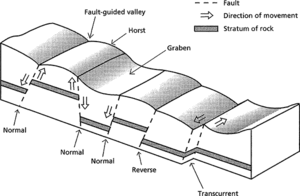A fracture in a planetary surface, on either side of which there has been relative movement parallel to the sides of the fracture. In a normal fault, the relative movement is vertical. In a transcurrent or strike–slip fault, the relative movement is horizontal. In a thrust fault, the fault plane is at an angle to the horizontal, and the upper side rides over the lower.
See failure.
A defect in any circuit or device that causes an error.
Approximately plane surface of fracture in a rock body, caused by brittle failure, and along which observable relative displacement has occurred between adjacent blocks. Most faults may be broadly classified according to the direction of slip of adjacent blocks into dip-slip, strike-slip, and oblique-slip varieties. The term ‘dip-slip fault’ comprises both normal and reverse slip faults, and the special cases of low-angle lag and thrust faults. Strike-slip faults (wrench, transform, transcurrent) result from horizontal displacement (dextral or sinistral movements), and on a regional scale may involve transpression and transtension. See also voids.
A fractured surface in the Earth’s crust along which rocks have travelled relative to each other. Usually, faults occur together in large numbers, parallel to each other or crossing each other at different angles; these are then described as a fault system. The slope of the fault is known as the dip. Where rocks have moved down the dip there is a normal fault; where rocks have moved up the dip, there is a reverse fault. A thrust fault is a reverse fault where the angle of dip is very shallow and an overthrust fault has a nearly horizontal dip. A fault plane is the surface against which the movement takes place. A tear fault is where movement along the fault plane is lateral. This latter type of fault may be termed a strike-slip fault. Regions, such as the Harz of Germany, that are split by faults into upland horsts or depressed rift valleys are said to be block faulted.

Fault
http://earthquake.usgs.gov/learn/glossary/ The USGS Visual Glossary provides definitions and outstanding photographs.
- post-productivist transition
- postreplicative repair
- PostScript
- PostScript font
- postseismic slip
- post-socialist city
- poststructuralism
- postsynaptic membrane
- post-tectonic
- post-tetanic potentiation
- post-transcriptional gene silencing
- post-transcriptional modification
- post-translational modification
- postulate
- postzygapophyses
- Post’s correspondence problem
- pot
- potash
- potash alum
- potash mica
- potassamide
- potassium
- potassium bicarbonate
- potassium bichromate
- potassium bromide